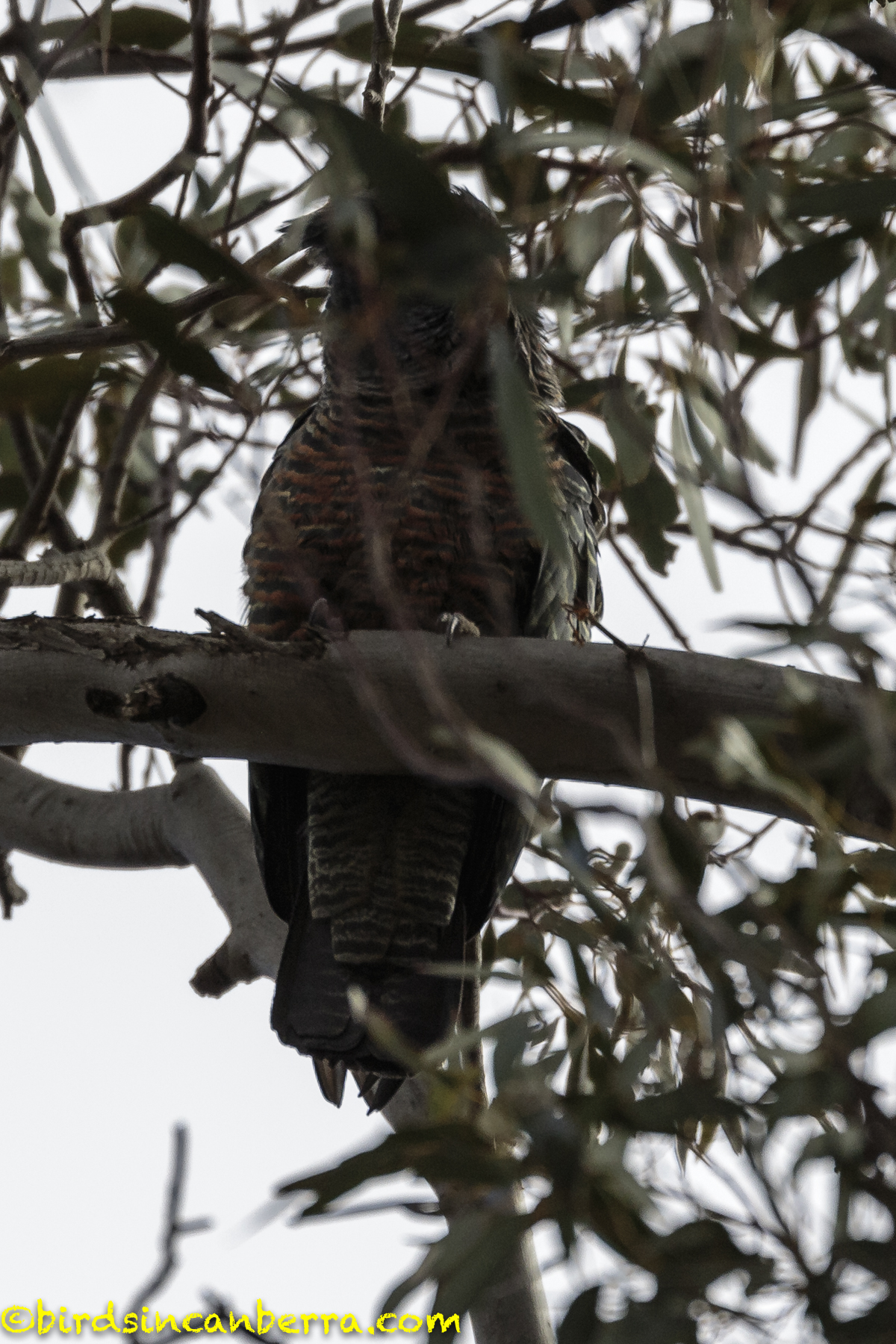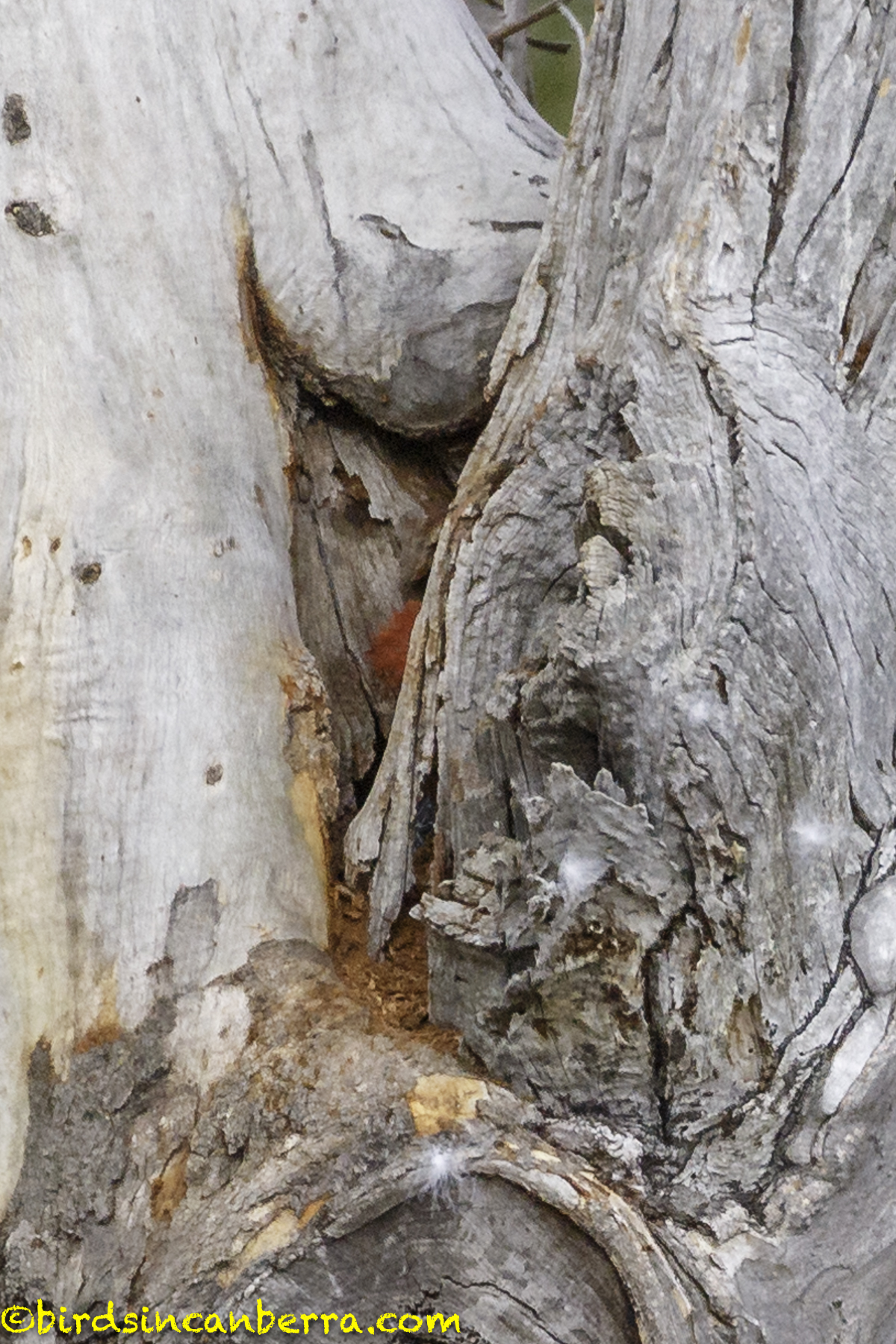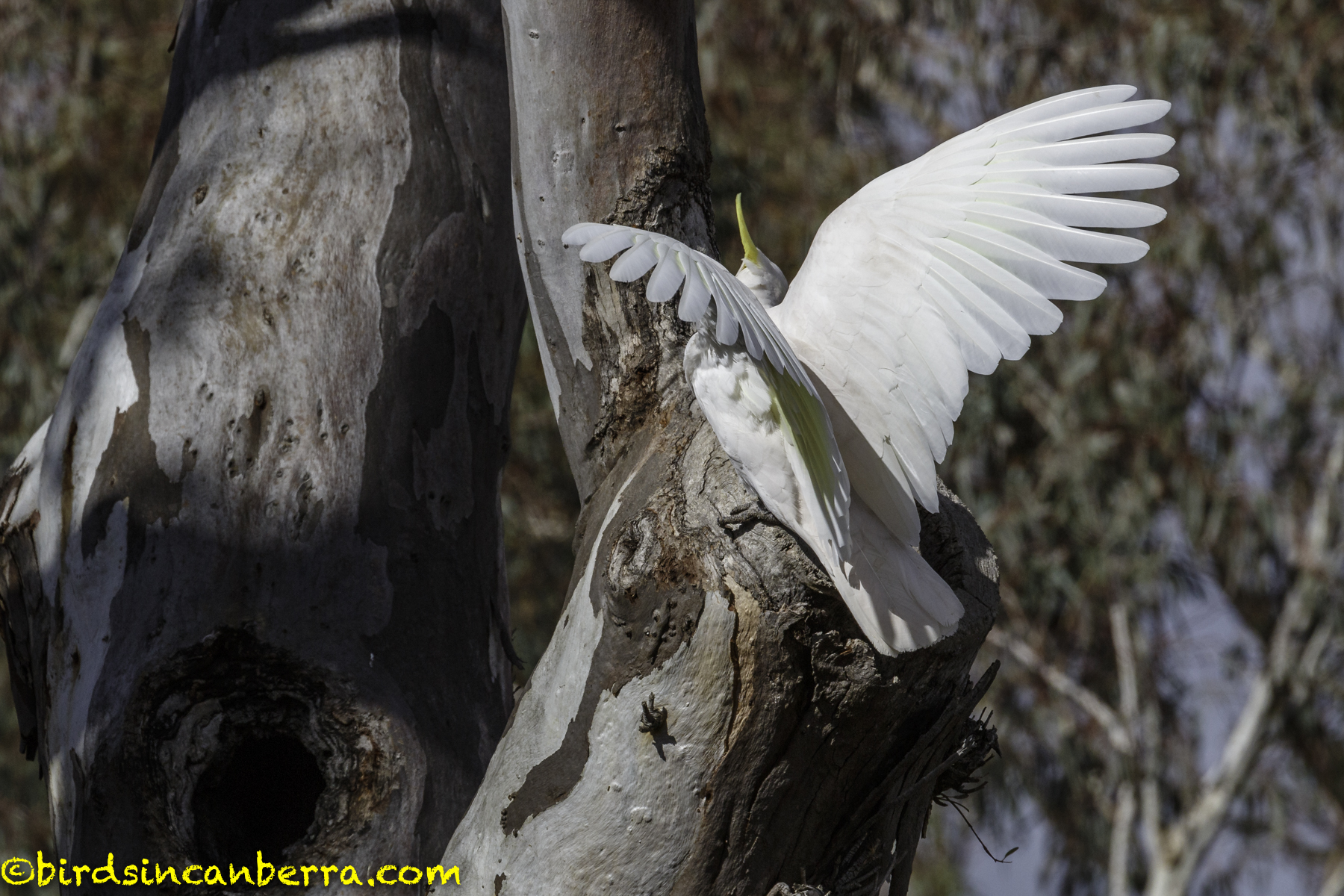I was not sure of the weather on Saturday morning but really wanted to photograph so I headed out under an overcast looking sky. The ambient light was initially not great but the sun broke through to create a wonderful sunny Canberra spring day. I was rewarded for my diligence as I believe I saw a tree hollow possibly being used by Gang-gang Cockatoos as well as a second tree hollow probably occupied by some nesting Australian Wood Ducks. The birdlife is becoming more abundant as the days warm up although I suspect it will still get better as there has not been an explosion of insect life yet, although the flowering plants will probably cause more invertebrates to emerge shortly.
As I mentioned above the morning started out very overcast, which you can see in the pictures of these two Australian King-Parrots. The bird on the left is possibly an immature male as his plumage is a little splotched. The bird on the right is a female. These birds were high up in a dead tree and they did not stay long,
Having had little luck with birds at my first location I walked to Red Hill Nature Reserve proper, taking a track behind the Telstra exchange. Walking along the grass at the back I spotted a Crested Pigeon and a Rock Dove apparently grazing on the same small part of grass. The Crested Pigeon flew off first as I approached, heading towards the trees while the Rock Dove flew to the wall of the Telstra Building, the surface in the background of the photograph. Australians generally call the Rock Dove a pigeon or feral pigeon or vermin with wings when they are being annoying. I tried to find out when they were introduced to Australia with West Australian government saying 1600s (does that mean from the Dutch?), a Sydney-based magazine claiming it was in Victoria before the first fleet and Birdlife saying the 1870s. I guess that means it is not too clear.
Entering Red Hill Nature Reserve I heard a group of five Noisy Friarbirds moving from tree to tree, mainly dead trees, as can be seen below. I was unable to catch all of them together, the two birds in the photo below left were the best I could do.
Walking on I heard the call of a Gang-gang but instead I saw some Galahs. There were three Galahs in a dead tree with a male Gang-gang making a very loud noise opposite them in a tree with foliage. As both species use tree hollows for nesting I am not sure if that was the issue. The galah in the photos below seems to have dirty wings, which may indicate it has been inside a tree hollow. The bottom photographs show a female who was the most animated. She was calling while moving her head up and down. She also started flapping her wings. When the male Gang-gang flew off she followed him while the male galah stayed put.
As I said above, I heard a Gang-gang Cockatoo but initially I only saw Galahs. The first photograph below shows the male Gang-gang calling out. After calling he would often look down at a lower branch of the tree he was on making me think there was something on that branch but I could not see anything. The female was much higher up in the tree, well into the foliage, I have included a photo, number two, more to show where she was as I know her face is obscured by the leaves. The male flew off with a Galah not so much chasing him but almost escorting him on his way. I figured the Gang-gangs would go further up the hill so I would see them again. When I climbed higher I heard a single call but I could not see a bird in any of the trees I had seen them in before. I was then distracted by a female Australian Wood Duck inspecting a large tree hollow, so I started photographing her. My attention was momentarily caught by some kangaroos hopping by, which drew my gaze to a tree a little distance away where I saw the male Gang-gang slowly climbing down a dead branch using both his feet and beak, as seen in photo three. I then noticed the hollow he climbed into, in photographs four to six. I included photo six to show the last bit of his crest disappearing as once he was in the hollow, he was completely out of sight, even when I moved around to where there was a better angle for viewing the hollow. I did not want to disturb him so I did not approach the tree. I only saw him again when a jogger went by and she was shouting to try to control one of her dogs who was not on a leash, despite the signs indicating the need to use leashes. The noise apparently bought the male out again, who went to the top of the dead branch I had first seen him on. After a short while there he descended again into the hollow and I did not see him again before I left. In looking later at a photograph of the overall tree I realised the female had also perched herself at the top of that dead branch after the male had returned to the hollow the second time, that is the final photograph. Again, I did not want to approach the tree if they were breeding so I walked off in the other direction.
Here is the Australian Wood Duck pair I referred to above. I initially saw the female peering into the hollow where is photograph one below. I suspect the hollow was deeper as she disappeared from my view when I was photographing the Gang-gangs but was back in the cleft of the hollow form nowhere when the same jogger I talked about above was calling her dog. The male stayed on the branch you can see him on in photo 2, as well as in the top left of photo three. I am not sure if my attention to their tree made them nervous, as they flew off to the large dead tree in photo 4 where there was another Wood Duck. Just in case I had disturbed them I left the area. I did not hear any females making their constant call, so they may be breeding now and not wanting to attract attention.
When I left the area near the Wood Ducks I could not miss the noise and movement of some Sulphur-crested Cockatoos. There was one at a tree hollow located where a branch had once been. I am not sure if it was looking for food or a nesting spot. It kept calling and raising its wings, photos one and two. I do not think it was falling, as it looked well balanced the whole time. I did notice it was missing its right eye. A group of four cockatoos flew in while I was watching this one. You can see what happened in photos four and five where a new bird forced the first bird to leave. A second new arrival also landed, the final photograph. These two new birds also turned around to bury their heads inside the hollow, again, making me think there was food there rather than a nest.
I also saw a pair of Australian Magpies around where the Gang-gangs and Galahs were making a noise, but the magpies did not seem perturbed by what was going on.
On my walk back my attention was drawn to three birds flying and hopping through some shrubs and small trees, they were Grey Fantails. There was much flying in circles and two flying around one in front of the other. Eventually, there was only two, so I am not sure if this was some form of mating with the losing bird departing or a male defending a female as indicated by some online reading I did.
The last bird I saw that morning was a Black-faced Cuckoo-shrike high in a eucalyptus. The bird flew into the tree from the southwest and after a brief while in the tree continued to fly northeast.
I saw a number of Eastern Grey Kangaroos and I have included some photographs below. I liked the angle on the large male in photo two and I found the joey in photo four too cute such that I had to take a photo.
While I was out that day I thought I would practice some macro photography with this Meat Ant nest. I dd not want to disturb them as I was just practicing. The different colours are because of no flash on the left and a flash for the right photograph. I do like the result of the shot with a flash.



































